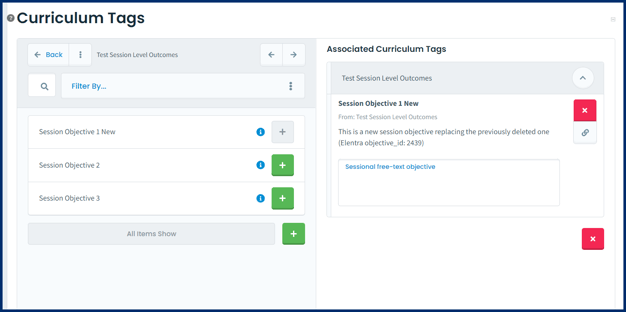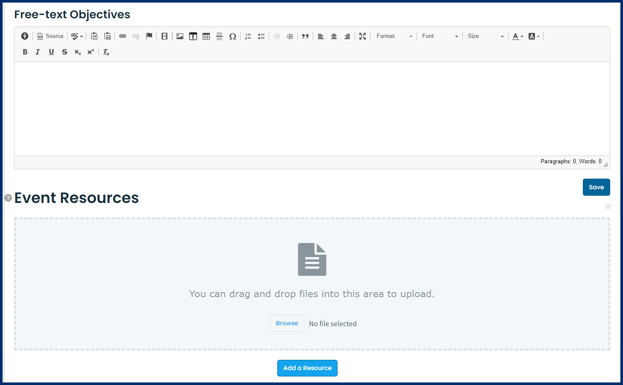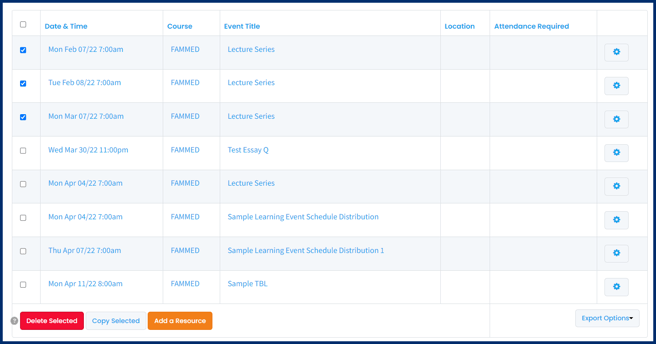Configure content delivery for learning events
Article Content
This article covers the following topics. Click on the topic to go to that section of the article.
Content Tab Overview

Tip: If you have mapped your learning event types to MedBiq assessment methods the mapped resources will display automatically. They can be removed from the event by clicking the small x.
Note: This a rich text editor and you can embed media, change the font, etc.
Event Objectives

Contextually Link Assigned Event Tags
- Context-based linkages DO NOT depend on the allowable mapping configurations set in Manage Curriculum for each tag set. You will be able to access any curriculum tag set when contextually linking.
- Context-based linkages are not stored in Admin > Manage Curriculum and will not display there.
Add a Contextual Link
- Search for the tag to select and click the green add button. The contextually linked tag will display under the assigned curriculum tag.
- To remove a contextually linked tag, click the x beside the tag name.
- To remove all contextually linked tags click the eraser icon and confirm your choice.
- Close the contextual link mapping drawer to return to assigning tags to the event.
Free Text Objectives

Event Resources
Note: Elentra does not have a media player. Audio/Video resources will download to the user's device. For online media content, try using the Streaming Media or URL options.
Reordering & Grouping Resources
- Click on the file folder icon to the right of a resource to create a section or move the resource to a section.
- Create New Section: Provide a section title and click Confirm.
- The newly created section will display below any other existing resources and will contain the resource from which the create action was initiated.
- Note that a section you create in one time frame (i.e., Before Class) will be automatically available in other time frames.
- Move to Section: Use the dropdown selector to choose a section to move the resource to and click Confirm.
- You will see a green success message and the resource should now display in the relevant section.
- To remove a resource from a section, click the folder icon and click Remove from Selection.
- To edit a section name, click on the folder icon to the left of the existing section name.
- Note that sections cannot currently be reordered and will display in the order created.
- There is no option to delete a section, however, if you remove all resources from a section, the section will be hidden.
Reordering Resources:
After event resources are added, they can easily be reordered by clicking on the resource and dragging it to a new position. Please note that you can only reorder resources within their designated timeframe (e.g., Before Class, During Class) and within any application section. Reordering resources on a recurring event series will NOT reorder resources on the other, linked events.
Event Feedback Forms
Feedback Forms are forms associated with an event as a resource. When added as an After Class resource, the form will be delivered to the A&E badge inboxes of the learners in the audience of the event; as well as appear on the event as a resource.
Note: Feedback Forms can be completed by anyone who has Learner View of the event. Feedback Forms can be completed as many times as desired by the user.
Data on completed feedback forms can be found in the Form Responses Report and in the Learning Event Evaluation reports. All Feedback Forms are considered to be learning event-based evaluations, for reporting purposes.
Caution: Feedback Forms added in the "Before Class" "During Class" and "No Timeframe" content areas will not deliver the forms to learners in the event in their A&E badge.
Bulk Event Feedback Management
- Optionally, generate an access code for the feedback from. These are optional features which require Elentra Support to enable them. Contact us to get started.

- Reminder that on third step of the wizard you'll see an option to make the resource available relative to the event start/end time. Enter the days and hours before or after the event start or finish.
- The setting you add will apply to all events.
- Select the appropriate form.
- If you have the access code option enabled, you'll also see an option to require an access code.
- Click Save Resource. Close the wizard.
- In Admin. or Teacher view, the event resource will have the Access Code displayed on the resource card (if applicable). Teachers should provide this code to learners to access and complete the evaluation.

